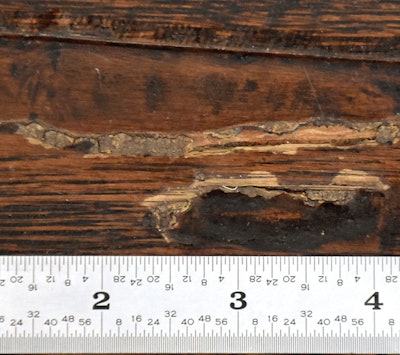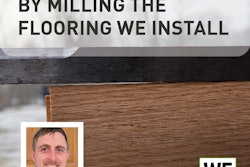
The Problem
I received a call from a homeowner regarding blemishes in her new floors.
What Happened
Factory-finished solid oak was installed on both levels of a new home in early 2019. Shortly after the home's completion, the homeowner began noticing floor "blemishes," and more occurred over time.
The Inspection
I noticed a textured surface to the flooring, similar to a hand-scraped floor. Multiple locations on both levels of the home had the blemishes, which were primarily in the field rather than along the board edges. Upon closer examination, I saw the blemishes consisted of missing and/or chipped finish, and generally occurred along a crack or check in the wood. Filler was observed at most blemishes but was chipped and missing from the blemishes in some areas. In some blemishes, islands of filler with sanding marks protruded above surrounding filler that did not contain sanding marks. Within most blemishes, the wood protruded above the surrounding area, and the protruding wood appeared to follow a crack or check in the wood. In some areas, the protruding wood formed a ridge in the unbroken finish.
The blemishes were consistent with improper surface preparation during the manufacturing process. The filler did not bond properly with the substrate, which can happen when the surface is contaminated with dust or other material. Improper filler bonding can also occur if it has cured too much before use. Other manufacturing issues did not adequately address the checks and splits in the wood, resulting in raised ridges and unstable edges of the cracks. Subsequent use of the floor resulted in movement along the cracks and separation of the filler and finish from the boards.
How to Fix the Floor
Normally, blemishes can often be individually addressed with spot-applied filler, stain and finish, but since this is a factory-finished textured floor with numerous unblemished ridges along checks and splits as well as unstable wood at existing blemishes, repairing the individual blemishes is not a workable solution. New blemishes will develop with time at the ridges, and wood at the cracks will continue to flex. The floors should be replaced.
In the Future
The manufacturer should make adjustments to address the underlying causes of the filler failure and unsound wood. The installer would not have been able to identify boards with these latent manufacturing issues during the installation.
RELATED: Recoating Prefinished Wood Floors Doesn't Have to Be a Gamble































